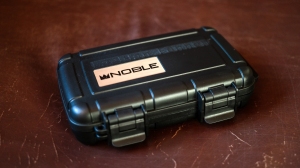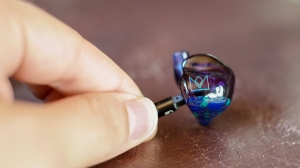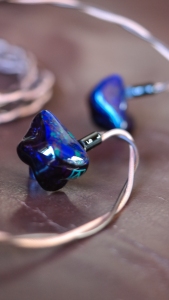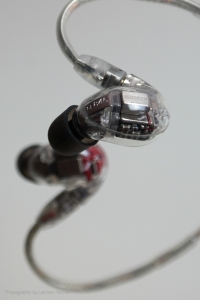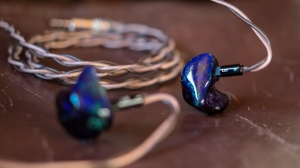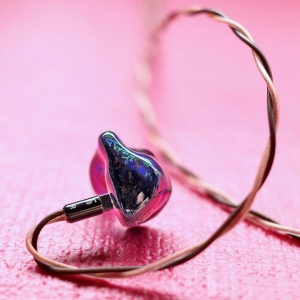A review of the Noble Audio Kaiser K10
Purchased from Addicted to Audio’s Melbourne store in January 2018.
It feels a touch strange reviewing a product that has now been succeeded by Noble Audio Encore, however with a few units still kicking about and my inbuilt desire to write about things, ultimately I figured I would love to share the experience.
Before I launch into the review I would like to introduce myself. I am if nothing else a walking cliché, for you see I am legally blind (though with some usable vision and an ability to see the full spectrum of colour) and I love to indulge my other fully functioning senses. I write about craft beer for something of a living, having recently completed the Certified Cicerone exam (awaiting results), indulging my sense of taste along the way.
I also enjoy high end audio. It is often said that blind and vision impaired people have a heightened sense of hearing. While I don’t wish to disprove this entirely, I would like to state it is certainly true a blind person’s sense of hearing is more adept than most people’s. You might be thinking I would have no trouble discerning or deciphering your voice - shouting or not - in a loud nightclub. The opposite is in fact the case. I abjectly struggle with it. Meanwhile, sat outside the family home, I my ears are tuned into every sound: the birds in the folks’ various aviaries and beyond in the surrounding gum trees; the dogs barking in surrounding kennel properties, plus our own as well; light aircraft incessantly flying overhead… Yup, it can be as overwhelming as it sounds. Yet I will still pluck out any detail where it needs to be heard or not, no matter how minor.
More importantly, as you’ll find out later on in this comprehensive review, I am also quite sensitive to a specific end of the spectrum, while being quite fond of its polar opposite.
In terms of assessing high-audio equipment, I’ll be the first to admit that such sensitivities and perhaps even sensibilities may be as much a blessing as a curse. On one hand I can pick out nuances, micro-details, faults and defining features in sound perhaps better than most. On the other, there are many headphones I would like to sample besides those I already own, however my ears being quite sensitive to treble, they mightn’t suit me quite as well as others. This is not to say I would not review them objectively.
Okay, now you’ve indulged me, it’s time to get on with the business of reviewing Noble Audio’s Kaiser K10 universal IEM.
A short introduction about Noble Audio and the Kaiser K10.
Noble Audio, as you might already be aware, is a boutique, “artisanal” (their words not mine) manufacturer founded in 2013 and based out of Northern California. The company was co-founded by one Dr. John Moulton AU.D, formerly of Heir Audio. The sharp-eyed among you will notice the AU.D. suffix, which alludes to Dr. Moulton’s specialisation in the field of audiology. Clearly he has quite the pedigree, for not only does he know intimately the inner-workings of the human ear, he is also an audio enthusiast with an unparalleled reputation for producing unpeered precision engineered IEMs from the ground up. But to you and me, us audiophiles, he goes by the unassuming pseudonym “The Wizard.”
Working alongside The Wizard is Noble’s other co-founder Brannan Mason, also known as “The Glove” or as “FullCircle” on Head.fi’s forums. He is the voice of Noble Audio if you will.
The two have appeared from seemingly nowhere, bringing with them a stellar line-up of headphones that cover all tastes and budgets. Those with elaborate and expensive taste can opt for acrylic customised enclosures to exotic wood. I presume this is common knowledge by now, and more information can be found on Noble’s website.
As I have already pointed out, the Noble Audio Kaiser K10 was the former sole flagship model offered by Noble Audio. At the helm today is a co-flagship pairing: the Encore, and the Katana.
Reading between the lines it is easy for one to deduce that the Encore is the elaboration on the Kaiser, an evolution rather than a stand-alone new entity. The Katana, meanwhile, was designed with the clear intent to forge their own frontier.
Though I would have happily purchased the Encore, the Kaiser ended up choosing me. Sort of. Fate had a hand in it. Addicted To Audio’s Melbourne store wished to part with its remaining Kaiser stock before introducing the Encore for demoing. I read somewhere the Kaiser’s bass was a little more pronounced, hence i opted for those ahead of the Encore. There was also the small matter of the timing of an advance payment available to blind DSP recipients (such as myself) twice-yearly which allows me to purchase such things as high end headphones. But we won’t get into too much detail about that.
What’s in the box?
Well, for start-offs there’s another smaller black box within the larger black box, that which is replete with Noble Audio’s astute livery. The smaller black box is a petite Pelican case to be exact, which is the perfect canvas for any one of the many stickers that have doubtless accumulated in your backpack. (Sadly the pictured Melbourne Hot Sauce sticker was the last of them). Otherwise purists will dig its shiny jet black and plush rubber lined interior.
Indeed a Pelican case can withstand just about anything you care to throw at it. Perhaps even surviving an aeroplane crash. Don’t quote me on that. Nor would I wish this upon anyone. Anyhoo, it is no small thing to receive high end accessories with a high end product.
Somewhere in there (I should have taken notes while unboxing) is the Noble Kaiser K10 IEM unit, itself made of aircraft-grade aluminium (more on the build quality later). It is worth noting the cable came literally bundled together, which damn near overwhelmed. But with the oldskool breaks tune that goes “if it don’t fit don’t force it” ringing in my ears I proceeded with caution, patience and perseverance. It wasn’t long before I had my breakthrough. I could then admire the glorious bit of kit before me.
Noble Audio has thrown in a range of tips to suit a broad spectrum of ear shapes and sizes here. There are foams, silicones and bi-flanges amongst them, but I personally have found best results using third party XL silicone tips from JVC’s Spiral Dots. These maintain their seal better than the similarly proportioned silicones as supplied by Noble. I would suggest bundling all your spares into the drawstring pouch provided.
And talk of stickers, you’ll also find a couple of Noble Audio stickers in there too - but good luck getting them off their backing!
In amongst it all is a shiny warranty card, which is of course well worth holding on to.
Design and build quality
Though there are limited release models (a black and rose gold option is still available at Addicted to Audio) I was lucky enough to purchase the last remaining pair of alluring red Kaisers on sale at A2A’s Melbourne (Australia) store.
In spite of me occasionally wondering if the Kaiser draws attention from fellow commuters who are confused as to whether or not Beats By Dre have released an IEM, I absolutely love the anodised maraschino cherry red and metallic white colours. The textural detailing is something you have probably read about before, but when you have the headphone in your hand it has a nice feel to the touch. The two part shell has a real weight to it too. Most importantly it strongly suggests that it will stand up to the rigours of day to day use.
If like me you use an iPhone 7 Plus and you have to take a call it may come as a shock when your earphone strikes the back of your phone. Both being made of aluminium neither device should sustain any damage (which is perhaps more than can be said for Apple’s earlier and latest glass bodied devices), but the resonant clunk as they connect is quite something.
True to form Noble Audio has included a stock cable that is no slouch in delivering the juice these bad boys need. You won’t find MMCX connectors here either. Instead you’ll find a two-pin connector is the order of the day. Indeed the cable is replaceable. If you are looking at your first ever pair of IEMs it is worth noting third party cables are a (few million) dimes a dozen. Copper litz tends to add more weight to the bottom end, while silver adds more to the top. Many are copper plated silver. Have a look around and see what takes your fancy, but I suggest allowing your newly purchased unit to burn in first. For now, the supplied cable does the job nicely. It is relatively thin as well (worth noting if you are coming from something like a HeadphoneLounge cable - the thinness can take a bit of getting used to). Like many high-end cables it is braided, which reduces (but doesn’t quite eliminate entirely) tangling. The male headphone jack is straight. Admittedly I’d much prefer an elbow but it’s no big thing.
Some people also like to cut off the memory wire. May I suggest that you don’t. I’ve not attempted to do so (or rather have my brother do it) on the grounds I feel it provides a bit of necessary resistance to each earphone’s heft.
Comfort is a big plus with the Kaiser K10 Universal. They do not cause any irritation or aching while inserted for any length of time, and their ergonomic design means the sensation of having something protruding in my ears is minimal. The Spiral Dot tips keep the comfort level and seal optimised even while on a brisk walk.
Much like the Shure SE846 the seal, for me at least, is not bad but it’s not great either. Then again I do have rather large ear canals.
Look beyond the tips and you’ll notice three porting holes. Inside the enclosures you will uncover (rhetorically speaking) a jaw dropping 10 drivers (also known as balanced armatures) per earphone, hence the Kaiser “K10” name. Two large drivers put out the bass, two mid-woofers roll in with midrange, the next two take charge of mid-highs, the next two tweeters blaze the highs, and the final tweeters fire it up with the top end of the frequency spectrum.
Perhaps the best part in all of this is how easy the K10s are to drive. They sound absolutely fine, great even, when powered with my iPhone or un-amped MacBook Pro. Though I am yet to acquire a superior source there is one thing that can be said of the iPhone and MacBook: they’re crystal clear, neutral, free of hiss (and that’s gotta be worth something!) in their output. If only Apple would bolster the power of its devices to support more headphones with greater impedance. For now I happily use the Onkyo HF Player app whose EQ settings work a treat (more on that later).
But I digress, the low impedance of the Kaiser (approximately 30 ohms) makes it a good fit for those whose setup consists of the most rudimentary of sources.
Sound
First, a little background: I came to the Noble Audio Kaiser K10 from the Shure SE846, an IEM I have owned and adored for nigh on four years. I loved their massive bass impact, particularly where electronic music (think progressive trance, techno and UK bass) is concerned. I am unashamedly a basshead. Once a basshead, always a basshead.
But I yearned for something more from my music. I recently found myself pining for what the Shure SE846 couldn’t deliver.
With no small amount of research and auditioning I arrived at the Noble Audio Kaiser K10.
I knew right from the off the Kaiser is a “neutral” IEM that leans slightly towards the warmer side of things. They are not considered a basshead’s IEM per se, but they certainly have more than enough to satisfy.
Most reviews start from the ground (sometimes going down as low as Hampstead tube depths where the Shure SE846 and Campfire Audio Vega are concerned). But I’m going to turn that on its head, just because.
Treble
Indeed, as much as my ears and mind favour strong bass response, equally they are incredibly treble sensitive. Treble is therefore perhaps the most difficult aspect of an IEM’s sound for me to assess. Nevertheless, I yearned for greater treble (amongst other things) and overall the Kaisers do not disappoint.
The Noble Audio Kaiser delivers what I would term silky smooth high end which really starts at the lower-treble region (bordering on upper mids). Listening to the haunting flute of “Mumbai Theme Tune” by A.R. Rahman, followed by the track’s cinematic strings (particularly the violins) and I can hear clarity, a palpable sense of realism, nuance. The Kaiser left me in doubt I was hearing air passing through the flute as well.
This same phenomenal piece of music reveals a lot about the Kaisers’ prowess at the top end of the spectrum. As the piece moves into its final passages and the notes get higher, the Kaiser handles them with aplomb. There is no sibilance, even at higher volumes from this inferior source, and the instruments are reproduced as note perfect as the recording and source will allow.
In terms of treble in music’s percussion department, snares snap with authority; their attack, sustain, decay and release add a real sense of depth to the musicality within the listening experience. Where reverberation is called for it’s there. Cymbals ring out with the same quickness and maintenance. Some say they want more sparkle but when you’re listening to high octane garage rock a la Dead City Ruins it’s the way it clatters that matters. Meanwhile the carefully mastered “It’s What We Do” by Pink Floyd yields much the same impression: cymbals are full of texture and fullness.
Even when the full spectrum is engaged in a track the Kaisers don’t fall apart at the seams like many before them do. No, so long as the mastering is equal to the music, these mighty IEMs chomp the veil into little pieces and gore the matador (hurrah!) instead of cowering beneath it. Just have a listen to Kieran Apter & Leon Power’s haunting “Drifting Spring” or Amorphis’ “The Skull” and you’ll see (or hear) exactly what I’m talking about.
Midrange
The Kaiser does exceedingly well in the midrange department. As Stereophile magazine founder and pioneer of audio equipment evaluation J. Gordon Holt once said: “If the midrange isn’t right, nothing else matters.”
Perhaps such a statement is a little surplus to requirement when before us is among the best of the best in IEM technology, but perhaps not. It can’t sell itself by default. A beer critic certainly wouldn’t overlook the malt character of a stout with a hefty grist and simply evaluate it as “good, malty and roasty toasty”, even if it is known to be particularly special.
If there is one aspect that really stands out with the Kaiser’s performance - over and above all else - it would have to be its prowess in delivering vocals. Female vocals in particular at times sound astonishingly and palpably “real.” When listening to Pink Floyd’s “The Great Gig in the Sky” (24 bitdepth FLAC vinyl rip) I found myself having to pick my jaw up from off the floor. Clare Torry’s non-lexical singing takes you deep into the emotional power and holds you there, its grip relentless until the very last tonally perfect note. And did I hear gargling in her throat!?
Similarly powerful, male vocals in heavy metal are reproduced with enough gravel to equal that of every accident sustained while riding a bicycle when I was little. A real sense of the singer’s hot breath exchanging from mouth to microphone only serves to enhance the conveyed sense of rage.
Cue Coldplay’s “A Rush of Blood to the Head” (remember when they wrote music that didn’t make you suspect they’ve become an industry band?) and once again the Kaiser delivers in conveying Chris Martin’s every note and every last bit of emotion. There are piano notes that ring out truer than I’ve ever heard before, the piano being reproduced exceedingly well by the Kaiser on the whole too. Interestingly the mastering of the album is caught with the bathroom door open (more on that later), but this is no bad thing. It only adds to the richness of the experience.
This same song reveals so much about the Kaiser’s strengths in the midrange department. Small wonder the guys at Addicted To Audio use this powerhouse IEM as a reference monitor. Midrange is presented so cohesively, with such brilliant harmony. Imagine the cycle of water as it goes from land or sea to the clouds, only to fall again as rainfall. The air between, that which resides in the middle this cycle, is to music’s midrange. At a moment’s notice the Kaiser is happy to provide a refreshing drizzle, let it rain or show off a thunderstorm. It really depends on what the music calls for.
Above all else, musicality is maintained. Never before have I heard an IEM that compares to the musicality of the Kaiser. I found myself locked in a rhythm induced trance while listening to Cass & Slide’s “Glad I Ate Her.” It’s worth noting the soaring vocals sound particularly epic as well.
Bass
There is a lot to love about the Noble Kaiser K10’s bass. There is a tiny little bit to lament too.
I’ll start by stating that the Kaiser K10s’ bass is overall a thing of beauty. There is a richness in its texture the much lauded (by fellow bassheads) Shure SE846 simply cannot match. If I ever wanted to play the bass guitar learning by ear these are the headphones I’d be looking for. Just throw on BB King’s “Why I Sing the Blues” to get a sense of what i mean.
The bass guitar is an instrument with which these IEMs seem to have a saucy love affair. You get a real sense of the strings of David Gilmour’s bass thrumming beneath his fingers and up the fretboard throughout The Endless River, with each palpable note delivered with punchy accuracy. Moreover the sound of the bass (both Gilmour’s instrument and the reproduction of the low end as a whole) is so organic you could start a permaculture farm on top of it.
As one might expect from IEMs of this calibre there is absolutely no bass bleed whatsoever. Admittedly the Shure SE846s bass didn’t so much bleed either, however at times it did overwhelm. Other IEMs such as the IE800s deliver bass that has a certain degree of wow factor, however ultimately they are left behind at the station by the Kaiser when it comes to organic texture and dynamics.
But somehow bass falls short of perfection when electronic music is thrown into the mix, as least in terms of what I’m expecting. Without a doubt sub-bass is there, and kick drums pound with authority and resonance. The drums are of course surrounded by a luscious organic low-end texture, but the only thing the Kaiser is short on is a bit of visceral sustained impact where the bassline meets the beat. Yet it’s nothing a little bit of EQing can’t solve.
Bass (with EQ)
In the Kaiser’s case EQing to boost the bass works a treat in my humble opinion. Nevertheless there is a small amount of lament here. I really wish I didn’t have to EQ the Kaiser K10 when playing bass heavy tracks (particularly when sub-bass is concerned), even if the trade-off across the rest of the spectrum is minimal.
Indeed many of the tracks I listen to on a daily basis require a degree of rotund punch (kick drums), slam, impact and sub-bass presence. Where progressive trance is concerned the texture of the low end simply isn’t enough, the beat behind any track being as central to the listening experience as the melodies soaring above it. Where tracks have a restrained melody or there is a passage in any given mix where there is no melody at all (think any number of extended mixes / sets from the likes of John 00 Fleming), the beat is everything.
Furthermore, there are genres of electronic music such as techno, proper dubstep (a la DMZ, Mala, Coki, etc.) and drum & bass that require still even greater bass extension. Thankfully, and I reiterate, nudging up the lower frequencies does enhance the bass experience; sometimes even catapulting it to awe inspiring heights. Amazingly nothing at all is compromised (no bass bleed!), with the wonderfully organic texture remaining in tact with nary a suggestion of colouration. Moreover one simply cannot enhance sub-bass if it were never there in the first place.
If you are going to audition the Kaisers with a bit of EQ enhancement I would recommend throwing on Dubstep Allstars vol. 08: Mixed by Distance, though any FWD>> pre-Skrillex era dubstep will do. The tracks throughout this mix provide some serious bottom-end heavy action. In addition to the wonderfully textured low-end response, a serious degree of heft is added with EQing. The two dedicated, larger bass drivers in each earphone are clearly being made to work overtime - hopefully while not breaking a sweat.
What impresses me the most here is that at no point does the bass sound bloated. I had originally purchased the Shure SE846 as successor to my Sennheiser IE8s, which at that time boasted good bass but no sub-bass presence. The Shures certainly do go down limbo-low but often sound uncontrolled, bordering on boomy. Moreover, when matched to the recently auditioned Campfire Audio Vega, the Kaiser’s bass when EQed is more than equal.
Moving on to Calibre’s piano-tinged drum & bass and the EQ needs to be dropped a tad. After all, this is jazz-inflected liquid drum & bass that is more than your typical dark, moody atmospheres associated with most of today’s D&B).
EQ enhancement really does take the Kaiser’s bass to the next level. Suffice it to say it’s rarely needed when playing other genres of music. But for those of you out there who, like me, listen to electronic music regularly, this is need to know stuff.
Soundstage, imaging, space.
The agility and flexibility of the Kaisers continues in the area of soundstage, space and imaging. Never before have I heard an IEM that can so easily and readily contract and expand - almost like a pair of lungs - to suit the music it is reproducing.
The Kaiser takes live recordings and makes them its thing. They leave little doubt in the mind as to the size of the venue in which the song or performance was recorded, while also placing you right up front - up close and personal.
Moreover, you know you may well have reached IEM endgame when you can feel a palpable sense of what the temperature was like at the time of recording. Take a listen to Iron Maiden’s En Vivo! live album, recorded at Santiago, Chile’s gigantic outdoor stadium. Not only can you hear Bruce Dickinson’s vocals soaring and echoing away over the heads of the audience and into the thin cold air, you can even hear how the cold air affects the music. And when Dickinson’s voice isn’t loud enough to echo into the distance it becomes abundantly clear you’re standing very close to the front. The sound has that great a dynamic about it.
Equally impressive is the live recording of Paul Oakenfold’s set at the NEC, Birmingham in 2001. Turn it up and suddenly you are again somewhere not too far from the front (within the first third of the NEC arena at least). Close your eyes and you’re suddenly a part of the experience. It sounds cliché but I really do mean it!
Smaller clubs, like Godskitchen in Birmingham, are equally well represented by the Kaiser’s soundstage. I’m reminded of big room trance nights held at Perth’s 2,000 capacity Metro City nightclub so perhaps the layout of the venue and its scale could be similar. No other IEM I have encountered has ever had me evaluating soundstage on this level.
Trance and techno are of course stratified in their nature, with each layer stacked upon one another, existing generally within a fairly narrow periphery. The Kaiser doesn’t just mash the lot up, it ensures there is structural integrity from the bassline to the percussion to the synths, maintaining fluidity and enough space between each. Even in this infamously congested genre of music the Kaisers provide enough room to breathe.
Breath as well as periphery are essential elements of reproducing orchestral music - something most IEMs fall short of accomplishing at any level, leave alone soundstage and imaging. The Kaiser has risen to the challenge yet again. While listening to the orchestral version of Mike Oldfield’s Tubular Bells, the music’s periphery contracts and expands according to the music, with violins and other strings projected out to an impressive point well beyond the ears. When the Ciello makes its presence known it too is off out to the periphery, and wow is the bass on it something else… Like most recordings the Kaisers place you directly in front of the stage, and you have the entire concert hall to yourself.
It is impossible discussing space and imaging without making another example out of The Orchestral Tubular Bells. I could quite easily illustrate where each musician is positioned if only I could draw. (There are violin players directly in front of me too). Unfortunately my limited musical education doesn’t stretch as far as to the layout of a typical orchestra, however I would like to think the Kaiser has placed every single musician with deadly accuracy. Moreover, Mike Oldfield being the perfectionist he is would have overseen the recording of this rendition of Tubular Bells. You can therefore assume he has gone the extra mile in ensuring an optimal recording. One thing I do know about classical music is it is incredibly difficult transposing it to digital means.
The space afforded by the Kaiser can be further exemplified by either album within theTubular Bells trilogy. Take your pick. And if you have never heard them, forgive my bluntness but you go now! And don’t come back until you do. Even if non-lexical music that defies all genres isn’t your bag. It is music that needs to be heard to be believed.
Once upon a time I believed I knew Tubular Bells II. In Oldfield’s eyes I might be going a step too far in saying that this is how he would imagine his music to be heard. At the very least it’s surely not far off. Each instrument is captured with vivid energy, and the Kaiser gives each one its own designated space to scintillate. The soundstage goes wide when called for and towers to the heavens above too with the thunder of an orchestral bass drum.
And then like the aforementioned air between the water cycle, it’s all tied together once more to become the greater sum of its parts again.
The details
From every pluck of a string to every mistake and from every tinkle of a xylophone (no other headphone has managed to reproduce that found in Dire Straits’ “Love Over Gold” with such coherence!) to the micro-details of an orchestra, nothing is left behind to the ether. The hallowed air beneath the guitar strings and the release of a piano note are all there to be discovered.
Let it be known that, as per the reference to the mastering of A Rush of Blood to the Head, the Kaiser takes no prisoners when it comes to lousy mastering. This is not a bad thing in and of itself, although you may find yourself reaching for your favourite albums a little less if the recording is sub-par. You cannot expect them to add much to pop music whose spectral dynamics are constrained either.
Comparisons
Shure SE846
Throughout this review I have drawn many a comparison to the Shure SE846, a headphone I knew and loved for nigh on four years. I have been forced to defend the Shure SE846s on numerous occasions and here I will defend them again, in spite of the concession that the Kaiser is a cut above. The Shure SE846 are a headphone that does exceedingly well at what it set out to do: Deliver a bass experience that is unlike any other. Truly it is unlike any other with its subwoofer like heft! And sometimes I miss it.
The Shures excel at all live recordings in their own special way. Those who are lucky enough to possess both the Shures and Machine Head’s Burn My Eyes [limited edition version], cue up the live recording of “Davidian” and let your ears and mind melt. The distortion is so vividly hot (in a good way), and the intimate soundstage (remember I said “defend?”) of these IEMs reproduces a palpably real experience of being front row centre in what seemed to be a very small room indeed. It sounds great even if it’s not an entirely accurate representation of the environment in which the song was recorded. The Kaiser still keeps you front row centre, but the size of the venue is revealed to be much larger while crowd noises are slightly more present.
That being said, the Kaiser’s treble leaves the SE846s for dead. Even when introducing the white filters or no filters at all, which greatly increase treble, the Shures become too hot to handle - especially for my treble sensitive ears. Moreover, the midrange I once considered as being plush now seems stultified by comparison.
If you are on a similar trajectory to me and you are looking for a step up from the Shure SE846, look no further.
Noble Audio: Katana
When auditioning the Kaisers K10 I also spent some limited time with the Noble Audio Katana, the company’s co-flagship.
It is worth noting that the Katana came after the Kaiser, arriving more or less alongside the Encore. It also came with the same custom-built drivers. Noble built and tuned each of the Katana’s drivers (nine in each earphone) themselves, and they did so with the intent of appealing to a crowd with a taste for the high life.
This is not to say the Katana lacks bass. Far from it. They do go down low when called for. However, the overall presentation errs on the scintillating, almost analytical side where the presentation of the Kaiser is one of warmth. From what I remember of the testing I found UK bass from the likes of Pinch to have an altogether different complexion, while “Sultans of Swing” shone as I’ve never heard it shine before. Ultimately though I was blinded by the light. I yearned for that pillowy warmth offered by the Kaiser.
Noble admits that perfection is a moving target. Your taste will ultimately decide which is the superior IEM between the Kaiser and the Katana. A very nifty thing indeed it is to have two flagships: equal, yet equally opposed.
Noble Audio: Encore
I am hopeful I can do a truly in-depth comparison between the Kaisers and their illustrious successor before too long. My understanding is the Encores feature an evolved midrange and added upper end sparkle, which one might expect from drivers custom made and tuned by Noble themselves. Watch this space. I am also curious as all get out as to how I would enjoy and interpret the Encore’s bass, which is said to be somewht more “controlled.”
Conclusion.
With their breathable sense of space; palpably real, organic, textured bass; visceral mids; superbly well rounded treble; and a neutral-to-slightly warm presentation; the damn near faultless Kaiser K10 stands tall among an ever growing forest of TOTL IEMs. Once more it bears mentioning there are still a few units up for grabs about the place both brand new and second hand. I can’t recommend giving them a try highly enough. You won’t just be hearing music, you’ll be experiencing it as it should be experienced.
Most tracks tested are in mp3 320 kbps mp3/aac - unfortunately most electronic music is not available at anything higher - or ALAC unless otherwise stated. Finally, it goes without saying your mileage may vary when using other sources, amplifiers and materials.














